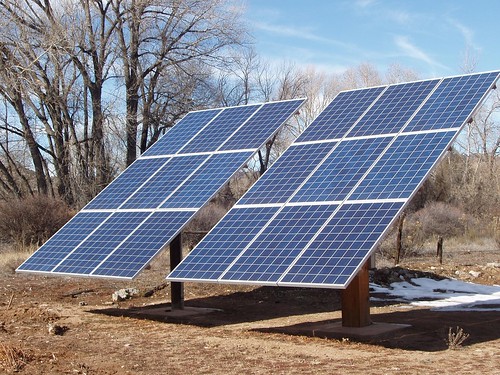
This eighteen solar panel array is generating more than enough electricity to offset the cost of energy it takes to run the Los Ebanistas, Inc. contracting firm’s woodshop and offices in Dixon, NM on an everyday basis. The extra energy that is generated is then routed back into the electric grid allowing Los Ebanistas to make a profit on the additional energy.
It’s 8:20 AM and Jo Ann Shelby, the manager of Compass Components, in Deming, New Mexico is beginning her day by going over her latest work production and business expense reports. She finds the cost of electricity to light the 90,000 square foot assembly plant is down 50 percent.
At the exact same time across the state in Dixon, New Mexico, Mark Johnson the owner of Los Ebanistas, Incorporated construction firm is in his office and hears the sound of a table saw ripping a piece of oak. He knows even though he’s using the same amount of electricity as he did last year, he’s actually making money.
What do these two businesses have in common? The answer is simple. They both invested in energy efficient and renewable energy systems with the help of the federal government.
Both businesses applied for and received financial help to offset the cost of installing these new energy systems through the Rural Energy for America Program (REAP) administered by USDA Rural Development. The REAP program was created to help agricultural producers and small rural businesses take advantage of installing alternative energy systems to help them be more competitive in their business dealings and at the same time help America become more energy independent.
This program can offset the cost of installing energy efficiency or an alternative energy system with a 25 percent grant. REAP can be used to pay for the installation of energy efficient air conditioners, heaters and lighting systems. It can also be used to pay for the installation of bioenergy, flexible fuel pumps, small and large wind and solar; geothermal-electric generation and direct use; hydropower, hydrogen, and anaerobic digester systems.

The main assembly plant building at Compass Components, Inc. in Deming, New Mexico is now equipped with a new more efficient lighting system. By replacing the old fluorescent light system the company is now saving 50 percent on its lighting bill.
Using the REAP program Compass Components Incorporated (CCI) installed a new lighting system at the Deming assembly plant. CCI received a grant to offset the cost of installing the new energy efficient lighting system. The system replaces 630 fluorescent tube lights with 48 energy-efficient T-8 Hi-Bay lights. Since installing the new lighting system CCI has seen enough savings in its electric bill to recoup its investment in a few years.
Los Ebanistas, Inc. received a grant to help pay for the cost of the installation of an 18 panel solar power system. The new system provides enough electricity to power the Los Ebanistas offices and woodworking shop where they manufacture custom cabinets and furniture. By making the investment to install the solar power array, Los Ebanistas has become more energy efficient and more profitable at the same time because it sells the extra power its solar array produces to the Jemez Mountains Electric Cooperative.
USDA is currently accepting applications for funding through the REAP program. To find out more, call your local USDA Rural Development State Office.
No comments:
Post a Comment
Note: Only a member of this blog may post a comment.